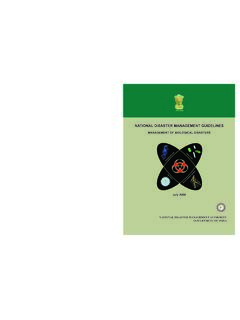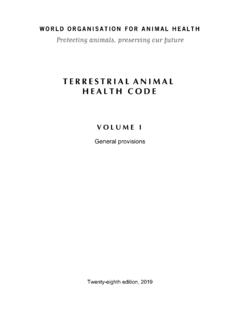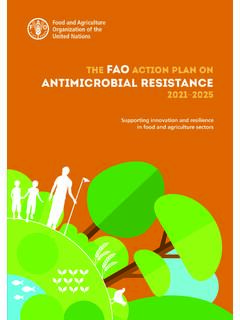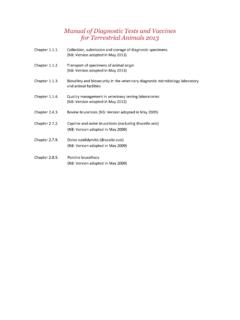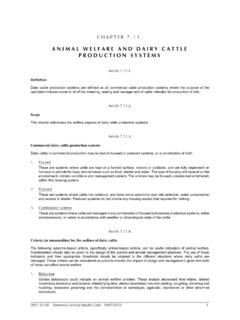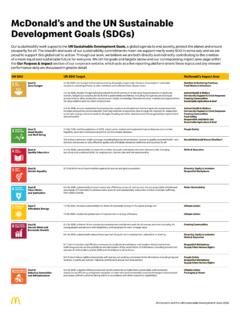Transcription of OIE standards and guidelines related to trade and poultry ...
1 11 The World Organisation for animal health : OIE standards and guidelines related to trade and poultry diseasesChristianne Bruschke and Bernard VallatWorld Organisation for animal health , 12, Rue de Prony, 75017 Paris, the difficulty faced by some countries in fully eradicating animal diseases from their territories as a whole, or to maintain animal disease-free status in parts of their national territories, the World Organisation for animal health (OIE) has introduced the concepts of zoning and compartmentalization for purposes of disease control and interna-tional trade , in the terrestrial animal health Code.
2 Compartmentalization is based mainly on functional separation by biosecurity measures, whereas zoning is based mainly on geo-graphical separation. Relevant animal subpopulations should be clearly defined, recogniz-able and traceable, and should be epidemiologically separated from other subpopulations. Veterinary authorities as well as the private sector have important responsibilities in the establishment and maintenance of words: OIE, standards , guidelines , compartmentalization, zoning1 IntrOductIOnThe World Organisation for animal health (OIE)1 is an independent intergovernmental organization founded in 1924, and having 172 member countries in January 2008.
3 OIE s mandate is to improve animal health worldwide. The organization achieves this mandate through its six primary objectives, which include ensuring transparency in the global animal disease situation, permanent update of disease prevention and control methods, provision of international solidarity in the control of animal diseases, publication of international ani-mal health standards , and improvement of the legal framework and resources of veterinary services. For several years, the OIE has also had a strong focus on improving animal pro-duction food safety and animal welfare. OIE s headquarters are in Paris (France), and there are nine regional offices in the five regions.
4 The OIE now has two regional animal health centres operating in collaboration with FAO, based in Bamako and Beirut, and is planning to establish other centres that will serve as regional centres of order to fulfil the mandate to ensure transparency in the global animal disease situ-ation, the OIE manages the World animal health Information System (WAHIS)2, based on poultry in the 21st Century2the commitment of member countries to notify the main animal diseases, including zoon-oses, to the OIE. In 2004, OIE member countries approved the creation of a single list of diseases notifiable to the OIE to replace the former lists A and B.
5 The content of the list is based on a decision tree which is part of the terrestrial animal health Code. Currently, about one-hundred diseases are listed; thirteen of these are poultry diseases, among which are highly pathogenic avian influenza (HPAI), Newcastle disease, Marek s disease, infectious bursal disease and avian infectious outbreaks of all listed diseases should be officially notified to the OIE central bureau within 24 hours, and regular update reports should be provided on the outbreak situation. The information is immediately disseminated to the delegates of all member countries, who can use it to analyse the risk of introduction of diseases into their own countries.
6 Mem-ber countries must also provide six-monthly reports on their animal disease situation. The World animal health Information Database (WAHID) interface provides access to all data held within WAHIS4. The OIE animal health information department actively approaches delegates to verify unofficial information on outbreaks of animal diseases in member coun-tries. In the Global Early Warning and Response System (GLEWS), a cooperative mechanism between OIE, FAO and WHO, the official and unofficial outbreak information of the three organizations is shared to allow better intervention, better analysis of data and more tar-geted capacity-building in relevant member the international standard-setting body for animal health , the OIE has defined stand-ards on notification, trade aspects and surveillance of the listed diseases, including the poultry diseases.
7 The aim of the terrestrial animal health Code5 is to ensure the sanitary safety of international trade in terrestrial animals and their products, by detailing the health measures to be used by the veterinary services of importing and exporting countries. The measures are also meant to avoid the transfer of pathogenic or zoonotic agents without imposing unjustified trade OIE is in a continuous process of updating its disease standards , while taking into account the latest scientific information on the diseases. For example, the chapter on avian influenza in the terrestrial animal health Code was updated in 2004. The new chapter has several significant changes compared to the previous one, such as differentiating between low and highly pathogenic avian influenza and defining HPAI as an infection of poultry .
8 The chapter gives trade recommendations for poultry and poultry products like fresh meat, meat products, eggs, feathers and down. The terrestrial animal health Code also provides general guidelines for surveillance and specific guidelines by specific disease standards are further defined in related chapters, appendices and definitions, which include: standards for surveillance that have to be met if countries are to declare freedom from disease; standards for conducting risk assessments; humane meth-ods for killing animals if stamping-out of infected populations is necessary; methods for disposal of dead animals; biosecurity standards for poultry establishments.
9 standards for 2 The World animal health Information System, WAHIS: Sixteenth edition, 2007, available at standards and guidelines related to trade and poultry diseases3the inactivation of viruses; and definitions of infected and uninfected as applied to a country, zone or compartment. The OIE also publishes guidelines on the use of vaccination, when relevant ( for avian influenza prevention and control).The Code is accompanied by the OIE Manual of Diagnostic Tests and Vaccines for Terres-trial Animals (referred to hereafter as the Manual)6, which outlines a harmonized approach to disease diagnosis by describing internationally agreed laboratory diagnostic techniques.
10 The instructions in the Manual should be followed in order to allow comparison between results from different laboratories in different countries; for this purpose, quality systems should be implemented in laboratories. The Manual also gives general guidelines on prin-ciples for the quality of veterinary vaccine production and guidelines for the development, production and use of disease-specific avIan InfluEnza and nEwcaStlE dISEaSEThe spread of the current HPAI strain H5N1 has given rise to an unprecedented situation over the past few The disease has important economic and social consequences in affected countries, and humans may be infected due to its zoonotic nature.










